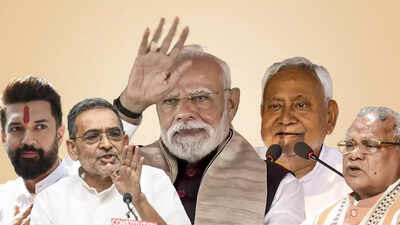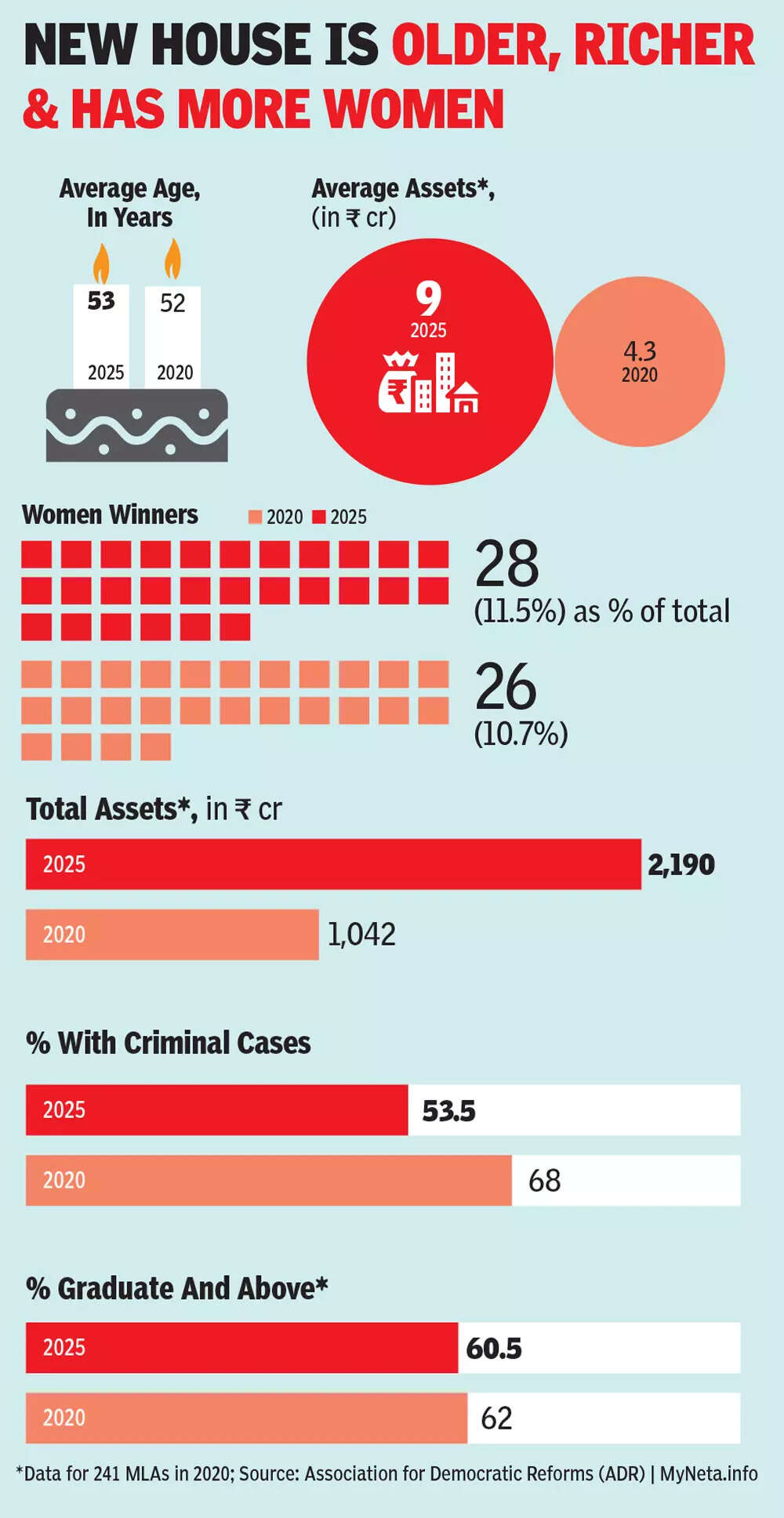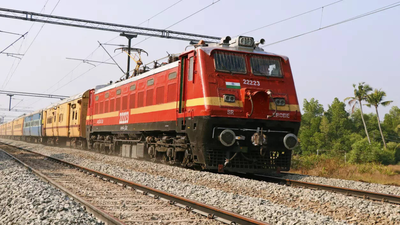Bihar Results 2025: Manifesto mandate, Nitish’s stability factor and more — What’s next for NDA | India News

NEW DELHI: The National Democratic Alliance (NDA) registered a decisive victory in the 2025 Bihar Assembly elections. The alliance won 202 seats in the 243-member assembly, with the Bharatiya Janata Party (BJP) emerging as the single largest party with 89 seats, closely followed by the Janata Dal (United) (JDU) at 85 seats. The Lok Janshakti Party (Ram Vilas) also performed strongly, winning 19 of the 29 seats it contested. The NDA powered through the Bihar elections, securing a decisive win despite opposition’s attempts to raise issues such as alleged “voter chori” by the Centre and the Election Commission, and campaigning around the Special Intensive Revision drive and Voter Adhikar Yatra. However, the NDA’s strong organisational machinery, coupled with its development-focused messaging, neutralised these allegations on the ground, leaving Mahagathbandhan struggling.
After such a massive victory, the next obvious question is – what next for NDA?

Manifesto as mandate
The NDA’s landslide victory sets the stage for a governance cycle anchored in its 69-page manifesto — a roadmap promising one crore employment opportunities, Mega Skill Centres and major infrastructure upgrades including expressways, new rail lines, and international airports in multiple cities.With commitments ranging from 10 new industrial parks, 100 MSME hubs, semiconductor and chipset parks, to transformative welfare pledges such as one crore Lakhpati Didis, expanded Kisan Samman Nidhi, free education for poor children, and 50 lakh new homes, NDA now carries a development agenda, which has to build upon Nitish’s decade-long ruling in the state.

Age, health narratives and Bihar’s same-old leadership
The election outcome brought a sharp generational contrast to the forefront. Nitish Kumar, 74, secured a renewed mandate even as the opposition showcased one of its youngest leadership line-ups in years. Despite attacks centred on his age, physical health and even insinuations about his “ill health,” voters ultimately sided with experience over experimentation.Nitish’s consolidated support among Kurmis, EBCs, Mahadalits, and women, boosted by central strength, effectively turned age into an advantage. His reputation as a steady, predictable administrator outweighed concerns over longevity or past political allegiance shifts.Thus, the upcoming term will hinge on the NDA capitalizing on Nitish’s stature as a veteran leader, coupled with the anti-incumbency narrative, while countering renewed questions about his age, particularly as this tenure will span till the time he’s 79.This becomes more significant, looking back on political rivals who had leaned heavily on this line of attack. Jan Suraaj’s Prashant Kishor repeatedly claimed Nitish was “ill” and “his mind not working”. RJD’s Tejashwi Yadav had also argued that Nitsh was no longer in full command and speculated around the JDU leader’s health.
Youth involvement: Maithili, Chirag a beginning – needs more
In his victory speech, PM Modi gave credit to “positive MY formula, and that is Mahila and youth”. Yet, taking a look at the elected MLAs’, overall youth representation is at a low. While NDA did use some new, young faces, the overall Assembly age actually is older. The average of NDA MLA-elects is 53, as opposed to 2020’s 52, suggesting that the overall demographic has remained unchanged more or less in the bigger picture.The standout is 25-year-old Maithili Thakur, whose decisive victory in Alinagar introduces a fresh cultural and youth-centric face into the BJP’s Bihar landscape. Her entry — as one of the youngest MLAs — symbolises youth outreach into its leadership pipeline. Chirag Paswan’s LJP (Ram Vilas), with 19 seats, adds another layer to this generational shift. Positioning himself as a “Yuva Bihari” while drawing on the legacy of his father, Ram Vilas Paswan, Chirag has emerged as a central youth figure within the broader NDA framework.Together, these leaders signal NDA’s start to blend legacy governance with new-age political capital, which needs to consider expansion on this formula.

Eyes on Bengal
In his victory speech, PM Modi moved beyond Bihar, positioning the win as a launchpad for the 2026 West Bengal Assembly elections. PM Modi said that “just as the Ganga flows from Bihar to West Bengal, this victory signals the BJP’s win in West Bengal as well.” West Bengal, which shares a border with Bihar, will hold its next assembly elections in April–May 2026, where Mamata Banerjee will seek a fourth consecutive term as chief minister.The themes that defined the Bihar campaign — welfare delivery, women’s empowerment, organisational cohesion — are expected to form the strategic backbone of the BJP’s Bengal playbook in a high-stakes battleground.
Tamil Nadu, Kerala, Assam: The big election year
The Bihar mandate feeds into the wider national playbook ahead of key elections in Tamil Nadu, Kerala, and Assam. The NDA might aim to replicate Bihar’s formula — welfare delivery, youth mobilisation, cultural messaging, and alliance cohesion — while adapting it to regional contexts.In Tamil Nadu, the battle will hinge on the anti-SIR narrative, as evident by TVK chief Vijay warning that the verification drive has left many unsure whether their names will remain on the rolls. “If I say that even at this very moment, not everyone in Tamil Nadu has the right to vote, would you believe it? Don’t think I’m trying to scare you… this is the truth,” he said, blaming the SIR.Kerala presents a similar SIR challenge, with the addition that the BJP has to break into a left-dominated ground.Meanwhile, in Assam, the contest centres on anti-incumbency. Himanta Biswa Sarma, who left Congress in 2015 and became chief minister in 2021, now faces his popularity test in 2026 as he seeks to secure a third consecutive victory for the BJP.






